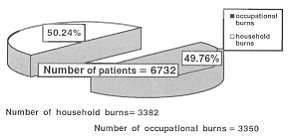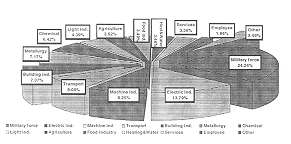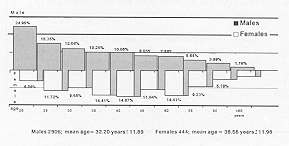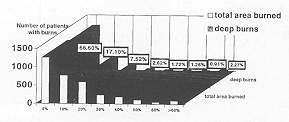| Annals of Burns and Fire Disasters - vol. VIII - n. 4 - December
1995
BURNS IN RISK PROFESSIONS
Hadjiiski 0., Kamburov Z.
Burn and Plastic Surgery Centre
Pirogov Emergency Medical Institute, Sofia, Bulgaria
SUMMARY. This
paper considers twenty years (1974-93) in the activity of the Pirogov Burns and Plastic
Surgery Centre in Bulgaria in relation to burns in professions with particular burn risks.
An analysis is made of distribution of burns by occupation, sex, age and sex, body surface
area burned, anatomical region affected, seasonal period, and time of day. An analysis is
also made of the mortality rate.
The Pirogov Burn and Plastic Surgery
Centre is the Republican Centre for bum treatment in Bulgaria, admitting burn patients
from Sofia and its surroundings, as well as country patients with large and severe bums.
Over a 20-year period (1974-93) 6732 adult patients with bums were admitted to the Centre.
Of these 3350 (49.76%) sustained their burn injuries at work (Fig. 1), in contrast
with the data of other authors who indicate a significantly higher incidence of household
bum injuries. Case distribution by profession showed that the highest number of patients,
462 (13.79%), worked in the electric industry, followed by machine building (9.25%),
transport (8.09%) and others (Fig. 2). Military personnel, who accounted for 812
patients (12.06%) of all burn patients hospitalized, were placed in a separate group. Of
these, 36 (4.43%) had sustained burns in relation to combat training while the others were
injured in construction or domestic activities. Flame was the most frequent causative
agent in this group; the bums were usually not extensive, and the mortality rate was
3.33%.
The commonest causative agents of bums sustained at work were electricity (605 cases:
18.06%), followed by burning petrol (573: 17.10%) and flame (370: 11.04%) (Fig. 3).
In most cases the causative agent corresponded to the patients' professional profile: in
persons working in the electric industry, electrical burns accounted for the majority of
burn injuries (88.96%); in persons working in the foodprocessing industry, boiling water
or steam (66.73%); and in the chemical industry, chemical compounds.
Case distribution by sex shows 2906 males and 444 females (male/female ratio: 6.55:1).
This index depends on the number of cases examined and the contingencies involved. The
male-female ratio varies in different authors: 213:113 (65.3%:33.7 %);2 23: l;6
67.55%:32.45% ;7 2.3A.0.1 The greater number of males affected at work is explained by
their more active participation in professions with a high bum risk, e.g. transport,
metallurgy, and the electric industry, in which females are less directly involved, their
participation being restricted to auxiliary, supportive roles. The male/female ratios in
the spheres of transport, metallurgy and the electric industry were respectively 53.20:1,
29.00:1 and 13.98A. Females predominated in the food-processing industry (2.00: 1) and the
services sphere (1.93: 1).
Case distribution by age and sex (Fig. 4) shows that younger adult males were
exposed to a higher risk of burns (52.38% of the contingencies studied concerned males
aged up to 30 years against 27.48% females). Our observations are confirmed by several
authors.',`,` The higher number of young adult men injured at work could be explained by a
low level of qualification and failure to observe labour security requirements. The mean
age of the patients was 32.20±11.89 years for men and 38.56±11.98 years for women.
 |
 |
| Fig. 1 -
Percentage of occupational and household accidents in the patients. |
Fig. 2 -
Distribution of patients by profession. |
|
With regard to body surface area (BSA)
burned, there was a predominance of burns in up to 5% BSA (37.62%), 6-10% BSA (23.26%),
and 11-20% BSA (17.79%), i.e. patients with burns in up to 20% BSA accounted for 78.67% of
all cases. Out of the 3350 hospitalized patients, 1982 (59.16%) underwent operations.
 |
 |
| Fig. 3 -
Distribution of burn-causative agents. |
Fig. 4 -
Distribution of patients by age and sex. |
 |
 |
| Fig. 5 -
Burn total areas versus deep burns. |
Fig. 6 -
Mortality rates for some professional groups of patients. |
|
Of these the number of patients with
operatively covered wounds up to 5% was 1320 (66.60%), up to 10% 17.10%, and up to 20%
7.52%, i.e. patients with up to 20% BSA burns operated on accounted for 91.22% of all
cases (Fig. 5).
The anatomical regions most frequently affected by thermic agents were the hand
(15.04%), followed by the forearm (11.80%) and the leg (19.37%); the commonest operations
were on the leg (19.37%), hand (17.95%) and forearm (11.70%). Some authors have reported
frequent hand injuries .3,12 The eyes were affected to some degree in 9% of the patients.
Burn localization varied in relation to the patients' professions: in electrical workers
the hands or face were most frequently affected, while the body or lower extremities were
the commonest bum localization in workers in the food-processing industry.
Occupational burns occurred mostly in the summer (June-August). The seasonal factor is
most apparent among workers in the agriculture, transport or construction fields. No such
tendency exists for workers in the electric, chemical and machine-building industries.
Case distribution by day of week shows that the bum rate increased gradually through the
week, reaching a peak towards the weekend (Friday). However, among electrical industry
workers, the burn accident peak was midweek (Wednesday).
With regard to round-the-clock rhythms, burns occurred most frequently between 7 and 9
a.m. and between 4 and 6 p.m., i.e. when beginning to work and when fatigue begins to
accumulate.
Of all the patients hospitalized for occupational burn treatment, 332 died (mortality
rate, 9.91%). This was highest among transport workers (11. 8 1 %) and workers in the
electrical industry (7.53%) (Fig. 6).
Conclusions
- Over a 20-year period 3350 adults with occupational burn
injuries were admitted for treatment to our Burns and Plastic Surgery Centre. Workers in
the electrical industry presented the highest burn risk.
- The risk of burns was higher in men than in women (6.55:1).
- The seasonal factor had a varying effect in different
professional groups. The majority of burn cases occurred at the weekend, and at the
beginning or end of working days.
- There was a predominance of burns in up to 5% BSA.
Operative activity was 59.16%.
- The overall mortality rate was 9.91%, the highest being
among transport workers (11. 8 1 %).
RESUME. Les auteurs
considèrent vingt ans (1974-93) de l'activité du Centre de Brûlures et de Chirurgie
Plastique Pirogov en Bulgarie par rapport aux brûlures dans les professions ayant un
risque particulier de brûlure. Ils analysent la distribution des brûlures par rapport à
l'occupation, le sexe, l'âge et le sexe, la surface corporelle brûlée, la région
anatomique atteinte, la période de l'année, et l'heure du jour. Ils analysent en outre
le taux de mortalité.
BIBLIOGRAPHY
- Belba G.J., Andrea A.: Some epidemiological data
regarding burn patients treated during 1992 in Albania. Ann. Medit. Burns Club, 7: 5,
1994.
- Christoforou M., Antonopoulos D.: Electrical burns
in south-west Greece - experience in the last three years. Ann. Medit. Burns Club, 5: 31,
1992.
- Courbière E., Lambrozo J.: Brûlures électriques
par accident du travail à EDF: une revue de 938 cas survenus durant la décennie 1980-89.
Ann. Medit. Burns Club, 5: 78, 1992.
- Flaberal M., Uqar N.: Analysis of 1005 burn patients
treated in our centre. Ann. Medit. Burns Club, 6: 73, 1993.
- Hanumadass M.L., Voora S.B.: A~ute electrical bums:
a 10-year clinical experience. Burns, 12: 427-31, 1986.
- Lochaitis A., Iliopoulu E.: Electrical burns: a
survey of 24 cases.Ann. Medit. Burns Club, 5: 75, 1992.
- Pardo L.: Epidemiology of burns according to sex
study in a Spanish regional burn unit. Ann. Medit. Burns Club, 6: 5, 1993.
- Iliopoulou E., Lohaitis A.: Statistical and
epidemiological data of 800 bum patients in a 5-year period. Ann. Medit. Bums Club, 3:
116, 1990.
- Boukind E.H., Chafiki N.: Les br6l6s: profit
6pid6miologique et 616-ments de prévention à propos de 1499 patients hospitalisés à
l'Unité de BrOks de Casablanca, Maroc. Ann. Medit. Burns Club, 7: 57, 1994.
- Jiz F., Kaddoura I.: Statistical retrospective
analysis of bum patients admitted to AUBNC between 1982-1987 (towards a changing future in
burn management). Ann. Medit. Burns Club, 2: 8, 1989.
- Rougé D., Nicolet B.: Les sévices par lésions
thermiques: étude statistique portant sur 93 cas. Ann. Medit. Burns Club, 2: 220, 1989.
- Ballaster C., Terren Ruiz J.: Epidemiological
analysis of patients admitted to the bums centre in Valencia during the year 1992. Ann.
Medit. Bums Club, 6: 224, 1993.
- Cast6de J.C., De Bonfils C.: Brfilures 6lectriques
des mains. Ann. Medit. Burns Club, 5: 216, 1992.
| This paper was presented at the 8th
MBC Meeting in La Corufla, Spain, in October 1994. Address correspondence to: 0. Hadjiiski M.D., Centre for Burns and
Plastic Surgery, 21 Macedonia Blvd., Medical Institut Pirogov, 1606 Sofia, Bulgaria. Tel.:
00.359.2.51. Fax: 00.359.2.52,17.17. |
NEUVIEME CONGRES
DU MBC
28 mai - 1 juin 1996
Tunis
Thèmes principaux:
Brûlures: Prévention et séquelles
Prévention des désastres d'incendie
Secrétariat scientifique:
Service de Chirurgie Plastique
Hôpital Aziza Othmana
Place de la Kasbah 1008 Tunis, Tunisie
Tel.: (216-1) 263-904 / 663-640
Fax: (216-1) 563-971 |
|





